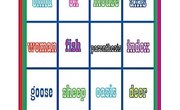In every language, there are certain elements of speech that come together to form a sentence. In most languages, there are nouns, adjectives, verbs and adverbs, which can be part of either a simple or complex sentence to portray a thought or idea or various thoughts and ideas. Although these elements may be easy to understand on the surface, there are times where it can get a little confusing. Therefore, it's important to know how to identify nouns, adjectives, verbs and adverbs, so you know where they belong in a sentence.
Why Learn the Parts of Speech
There are eight parts of speech that are typically found in any language, and they are nouns, pronouns, verbs, adverbs, adjectives, prepositions, conjunctions and interjections. While you might use all of these on a daily basis, studying these parts of speech more in depth allows you to really understand how to form great sentences. Knowing these parts of speech well can help improve your writing, editing and literary analysis skills. It can also help to learn another language.
The Four Basic Parts of Speech
Before learning all the parts of speech, it's a good idea to start with the basics: Nouns, adjectives, verbs and adverbs.
Nouns: A noun is any word that can label a person, place or thing. It can also be an idea or concept, such as "belief" or "happiness."
Verbs: A verb is not just an action word or a "doing" word as many people think, it's also a state of being. For example, the verb" to run" may be an action word that you can actually see, but the verb "to be", which is a linking verb, (am, is, are) isn't easy to visualize, but it is still a verb. Verbs change tenses, and you can conjugate them depending on who you are talking about and when the state of being is taking place.
Adjectives: An adjective is a word that describes a noun or pronoun. It gives the reader or the listener a bit more information about the noun or pronoun so that they can really envision what something appears to look like, smell like, sound like, etc. For example, the phrase "the car" doesn't tell you anything about the car itself. But, if you add some adjectives and say, "the shiny blue car," then you're providing more details of how the car looks,
Adverbs: An adverb is similar to an adjective, but instead of describing the noun or pronoun in a sentence, it describes the verb. An adverb can also describe an adjective or another adverb. A good way to determine whether or not a word is an adverb is by asking yourself whether or not it answers the question "How?" For instance, if the sentence was "Jane runs" then you can add the adverb "quickly." So, "How does Jane run?" "Jane runs quickly."
Parts of Speech in Simple vs. Complex Sentences
When using the parts of speech in a sentence, it's important to know the difference between simple and complex sentences. This comes in handy when you are editing or evaluating a text or writing one yourself.
A simple sentence is one that contains a subject (the noun) and a verb. It can also contain some adjectives or different verb tenses, but ultimately, a simple sentence can express one complete thought. An example is, "Tommy and Jane go to the store." You could also add some adjectives and change the verb tense, and it would still be a simple sentence. For example, "Tommy and Jane went to the fancy electronics store on 42nd Street."
A complex sentence, on the other hand, is when an independent clause joins one or more dependent clauses. For reference, an independent clause is when a sentence can make sense on its own, while a dependent clause cannot. To connect an independent clause with a dependent clause in order to make a complex sentence, the writer must use a word like "because, since, after or although."
An example of a complex sentence is, "Before the wedding, Alex and Andrea went to the store to buy a gift." The independent clause, "Alex and Andrea went to the store to buy a gift" can stand on its own, but the dependent clause, "Before the wedding" cannot. Put them together, and you get a complex sentence.
When you can identify not just what the parts of speech are but how they come together in a sentence, it can make you a better writer.
Related Articles
References
Writer Bio
Hana LaRock is a freelance content writer from New York, currently living in Mexico. Before becoming a writer, Hana worked as a teacher for several years in the U.S. and around the world. She has her teaching certification in Elementary Education and Special Education, as well as a TESOL certification. Please visit her website, www.hanalarockwriting.com, to learn more.











